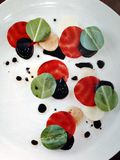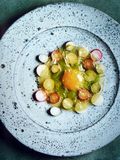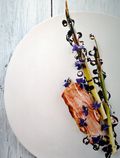19 Oct Recipes from Noma, the top ranking restaurant in the world
By Lisa Barlow
Editor's note: This is the first weekly column from new TIO contributor Lisa Barlow. Barlow is a writer and photographer who divides her time between New York, Telluride and San Pancho, Mexico. An enthusiastic omnivore, she specializes in stories about food. The photos above, from left to right: glazed beetroot and apples; poached eggs and radishes; pork neck and bulrushes, violets and malt. 
It’s easy now to imagine how Babette might have coped at the end of Babette’s Feast when she had revealed herself to be a kick ass French chef, but had run out of money and was destined to remain as a cook and housekeeper for two ascetic spinsters in the remote and unforgiving landscape of Jutland in Denmark. Forget the foie gras and the Veuve Cliquot, all she had to do to look for extraordinary ingredients and inspiration was to open her front door.
That’s essentially what Chef René Redzepi did when he was looking to use seasonal Nordic produce to create the menu for his Copenhagen restaurant, Noma, which this year unseated El Bulli at Number One in the 2010 San Pelligrini list of 50 Best Restaurants of the World.
Noma, Time and Place in Nordic Cuisine, Redzepi’s eagerly anticipated cookbook has just hit the shelves, showing us just why this is visionary cooking set on a new culinary frontier.
Entirely ingredient driven, the menu at Noma (an abbreviation of Nordisk Mad or Nordic Food) celebrates the local and the seasonal in such dishes as Fresh Cheese and Spruce Shoots; Danish Squid, Green Strawberries and Verbena Oil; Musk Ox and Fresh young Garlic, Milk Skin and Caramelized Garlic.
Trained in the cutting edge kitchens of Thomas Keller at the French Laundry and Feran Adria at El Bulli, Redzepi has taken what he learned and made it his own. As a highly skilled chef, familiar with all of the hottest new molecular techniques, Redzepi understood that the secret to great food lay in the ingredients themselves. And so he set off to locate them in Greenland, Iceland, the Faroe Islands, Sweden and Denmark. A hand-drawn map depicting the locations of his suppliers folds out at the start of the book and their photographs are interspersed with images of the food.
Redzepis’s ultimate breakthrough moment as a chef came when he realized that he didn’t just need to use Scandinavian ingredients to influence the character of a crème brulee or Demi-Glace sauced dish. He needed to de-link his creations from any references they had to a different history and background. “We pared [our food] down to the bone and made everything more transparent—more straightforward. If we had one special ingredient, we surrounded it with foodstuffs it lived among or on, or instance wild boar with corn and berries…It was no longer just food on a plate. There was a story contained in it.”
The story comes through beautifully in the book. Sumptuous photographs of raw ingredients and plated dishes alternate with images of fisherman, foragers, architectural details and the Nordic landscape. Redzepis’s own early diary entries are charming as he discovers the havthorn berry, sea buckhorn and horse mussels. And of course, there are recipes. None of which you will ever make. That is unless you live near a patch of goosefoot and are on familiar terms with a Thermomix. Phaidon is an art book publisher and that is what this book is, a gorgeous art book that reveals and rewards. You may, after reading it, be inspired to open your own front door and see what’s growing at your doorstep.
Noma: Time and Place in Nordic Cuisine
Phaidon Press (October 4, 2010
$32.97 at Amazon.com





Sorry, the comment form is closed at this time.